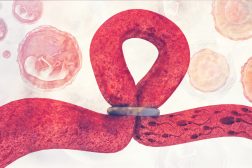Table of Contents
Definition
noun
plural: spectrins
spec·trin, spĕk′trĭn
A cytoplasmic membrane structure with contractile dimeric protein (240 & 220 kD) located under the plasma membrane, especially of erythrocytes, potentially restricting the lateral mobility of integral proteins
Details
Overview
Cytoskeleton is a cytoplasmic structure composed of protein filaments and microtubules in the cytoplasm, and has a role in controlling cell shape, maintaining intracellular organization, and in cell movement. In eukaryotes, there are three major types of cytoskeleton, namely (1) microfilaments, (2) microtubules, and (3) intermediate filaments. Other eukaryotic cytoskeletons are septin and spectrin. Septins form complexes with each other to create attachment points for other proteins inside the cell. Spectrins are proteins forming a meshwork under the plasma membrane, potentially restricting the lateral mobility of integral proteins. It was first isolated from human red blood cells treated with mild detergents that could lyse the cells and wash out other cytoplasmic components and leave out a mesh of spectrin cytoskeleton that preserves cell shape and outline. As if a ghost of the red blood cell, it was called spectrin (from spectre or Latin spectrum, meaning “ghost” or “apparition”).
Characteristics
A spectrin is a cytoskeletal protein located under the plasma membrane of eukaryotic cells, forming a pentagonal or hexagonal configuration. In invertebrates, spectrins include α,β and βH types. In vertebrates, particularly humans, spectrins include alpha-spectrins (i.e. αI and αII) and beta-spectrins (i.e. βI, βII, βIII, βIV, and βV). Spectrin forms a complex with ankyrin, actin and probably other components of the membrane cytoskeleton, so that there is a meshwork of proteins underlying the plasma membrane, potentially restricting the lateral mobility of integral proteins. Isoforms have been described from other tissues (fodrin, TW 240-260k protein), where they are assumed to play a similar role. Spectrins contain eF hand motif.
Inborn errors, Pathobiology, Genetics
Defective spectrin due to genetic mutation is associated with hereditary conditions such as hereditary elliptocytosis and hereditary spherocytosis. Both are characterized by hereditary defects of the erythrocytes. Human genes involved in the production of spectrin are as follows: SPTA1 and SPTAN1 for αI and αII spectrins, respectively, and SPTB, SPTBN1, SPTBN2, SPTBN4, SPTBN5 for βI to βV spectrins.
Biological importance
Spectrin provides a structural framework of the cell. For instance, it forms the meshwork that accounts for the cell shape of the erythrocytes.
Supplementary
Etymology
- from French spectre, from Latin spectrum (“apparition”)
Further reading
See also
© Biology Online. Content provided and moderated by Biology Online Editors







